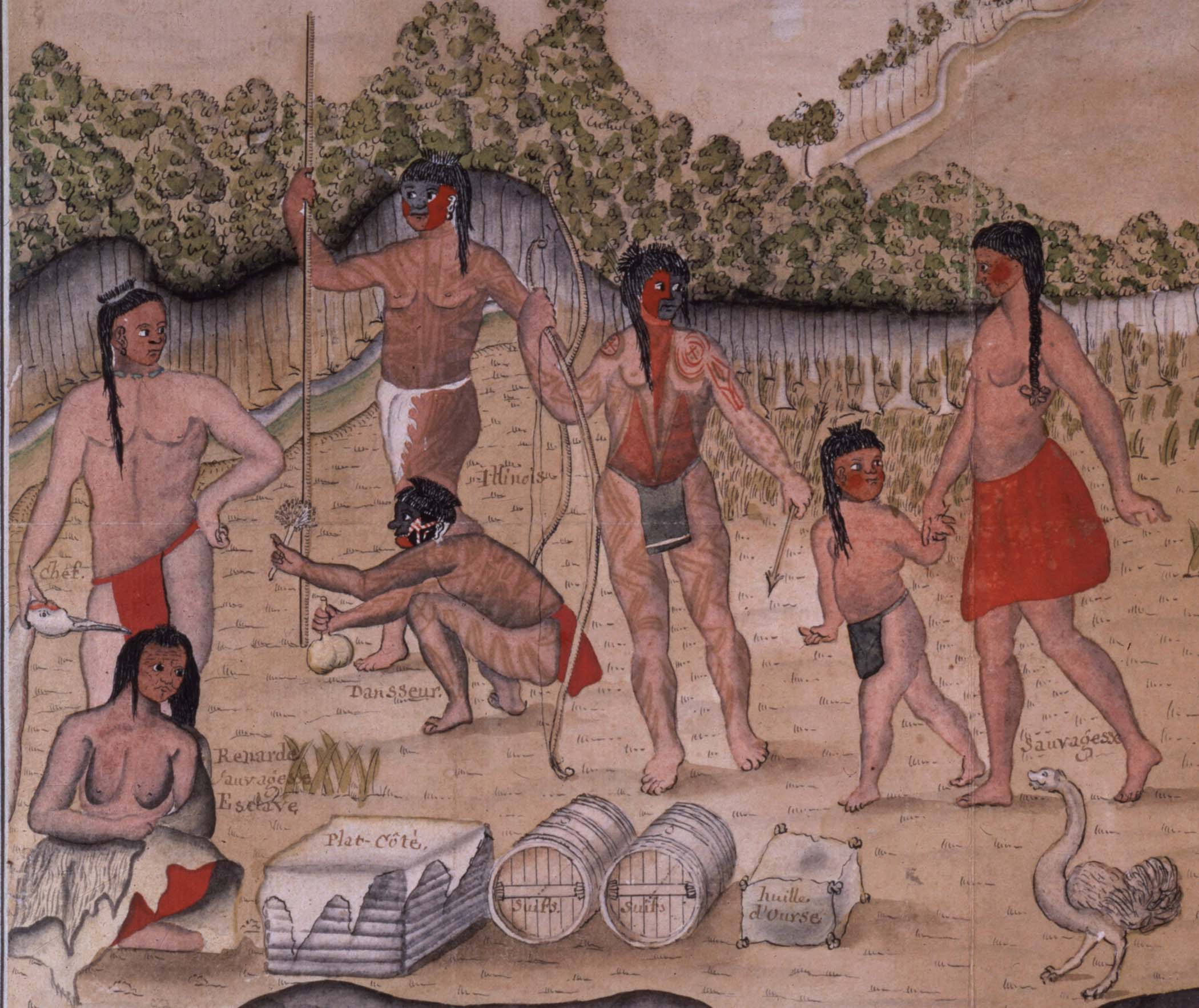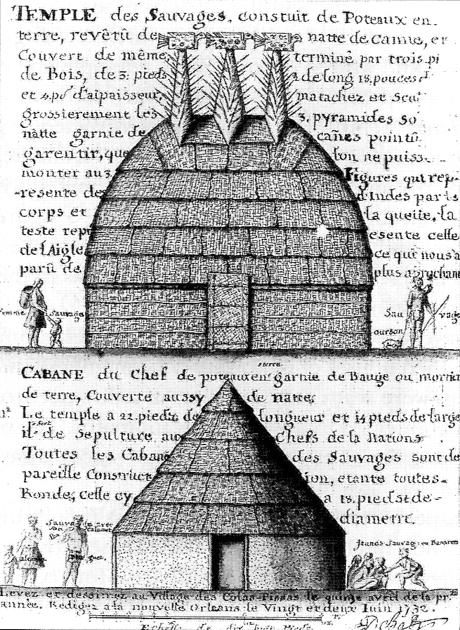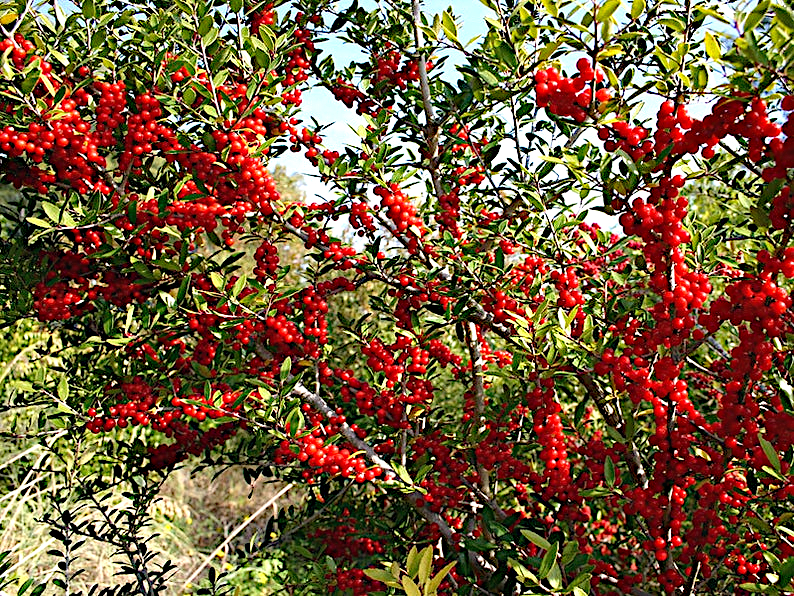Your search results [18 articles]
The Natchez and the Mississippi Company.
Antoine-Simon Le Page du Pratz left La Rochelle on 25 May 1718 with 800 men on board three ships to explore Louisiana. He stayed there for sixteen years, eight of which were spent with the Natchez Indians, learning their language, studying their culture and marrying a Chitimacha. Director of a concession for the Mississippi Company, his functions ended in 1728 during the Natchez revolt. Returning to France in 1734, he published his Mémoire sur la Louisiane (1751-1753), published in three volumes in 1758. Le Page du Pratz was one of the rare European authors who shared the life of the Amerindians and tried to understand their society without considering them as savages. His ethnological observations on the Natchez who live on the lower Mississippi River are irreplaceable. The Natchez do not consume fermented beverages during their most important annual ceremonies, but routinely barter their products for brandy. As early as the 17th century, French settlers brewed corn beer and distilled it. They did the same with sweet potato.
The French settlers adopted unanimously the cultivation of maize: “Louisiana produces several kinds of Mahiz, namely the flour Mahiz; it is white, flat & wrinkled, but softer than the other species; the Mahiz for gruel or groats, this one is round, hard & shiny; of this species there are white, yellow, red & blue ones. The Mahiz of these last two colours is more common in the highlands than in Lower Louisiana. We also have the small wheat or small Mahiz, so called because its species is smaller than the others; we sow this small wheat when we arrive, in order to have something to live on quickly, because it comes very quickly and ripens in such a short time that we can harvest two crops in the same field and same year; in addition to this advantage, it flatters the taste much more than that of the big species.
Mahiz, which in France we call Turkish wheat, is the country's own grain, since it has been found cultivated by the natives.” (Tome 2, p. 3-4 : maize)
The settlers also learned from the Amerindians the nixtamalisation of maize with vegetable ashes and protracted cooking: “First of all, this wheat is half cooked in water, then drained and dried well. When it is quite dry, it is scorched or roasted in a dish made especially for this purpose, mixing it with ashes to prevent it from burning, and it is stirred constantly so that it takes on only the reddish colour that suits it. When it has taken on this colour, all the ashes are strained off, it is rubbed well and placed in a mortar with the ashes of dried beans plants and a little water; Then it is gently peeled, which breaks the skin of the grain and turns it into grits. This gruel is crushed and dried in the sun. After this last operation, this flour can be transported anywhere and kept for six months; however, it must be noted that one must not forget to expose it to the sun from time to time. To eat it, put a third of what it can hold into a vessel; fill it almost entirely with water, and after a few minutes the flour will be swollen and ready to eat. It is very nourishing, and is an excellent provision for travellers and for those who are going to traicte, i.e. to do some business.” (Tome 2, 5-6 : meal, groats and maize beer)
Le Page du Praz adds “Mahiz is used to make brandy, and the grain is used to make a strong and pleasant beer; the whole country and especially the hillsides provide an abundance of hops.” The cultivation of hops in Louisiana demonstrates a desire to brew beer according to a European technical formula and a curious crossbreeding with the maize beers of Amerindian origin. It should be remembered that Louisiana was also populated on the orders of Louis XIV by 800 settlers of German origin (Bossu Jean-Bernard (1778), Nouveaux voyages aux Indes occidentales. New Edition, Part 1, 44)[1].
The hop cultivation described by Le Page du Praz imitates the European techniques point by point: “Although Hops come naturally to Louisiana, those who wish to use them or sell them to brewers cultivate them. It is planted in rows six feet apart in holes two feet wide & one foot deep, where the root is placed. When it is well grown, a pole the size of an arm & twelve to fifteen feet long is planted in the hole; care is taken to bring the sprigs close to it, as they are sure to climb up. When the flower is ripe or yellowish, the stem is cut close to the ground, the pole is pulled out to pick the flower, which is then compressed.” (Tome 2, 57)
The settlers in Mississippi also adopted sweet potatoes and made them into fermented drinks: “They are cooked like maroons in embers, in the oven, or in water; but embers & oven give them a better taste. They are eaten dry or sliced in milk without sugar, because they contain it; they also make good jam. Some French people have made brandy from them.” ((T. 2, 10-11). Distillation involves alcoholic fermentation of a sweet potato decoction. Sweet potato beers are attested in the Caribbean area at this time and are of Native American origin. The settlers in Louisiana learned it from the Amerindians of Central America or more probably islands of Cuba or Jamaica.
This context implies that the Natchez have been consuming fermented or distilled beverages bartered by the settlers since the 17th century: "However, one good thing resulted from this: the Natchez were attracted by the ease of dealing in goods previously unknown to them, such as guns, gunpowder, lead, spirits, linen, sheets & other similar things, by means of an exchange of all that they had in abundance...” (Tome 1, 179)
A recurring question: did the Natchez themselves prepare maize or sweet potato beers according to their own traditions, before the arrival of the settlers? It seems not. The 16th century Spanish expeditions that passed through their territory provide no evidence of this, except the mention mazamorra, a possibly fermented slurry from maize. The annual ceremonies described by Le Page du Praz do not include any collective consumption of fermented drinks. On the contrary, this author specifies that the dances and songs that follow the ceremony of the new maize throughout the night are sustained by a single drink, water: “Besides, I must say that in this Festival there is never any disorder or quarrel, not only because of the presence of the Great Sun, and the good habit they have of living in peace, but also because only the sacred wheat is eaten and only water is drunk.” (Tome 2, 378)
The ceremonies preparing the warriors for expeditions use decoctions of Ilex vomitoria leaves and berries (very rich in caffeine and theobromine) to prepare cassiné or asi: “Then the war drink is brought: it is made of a quantity of Apalachine leaves boiled in enough water to be cooked in spite of their hardness; it is by pressing them strongly that this drink is extracted which intoxicates.” (Tome 2, 424-425). The drunkenness referred to by the author is not alcoholic.
Finally, Le Page du Praz makes a decisive observation: the Natchez do not know the techniques of alcoholic fermentation and do not want to learn them: “All these people [the Natchez and their neighbours the Chicachas] are prudent & speak little; they are sober in eating; but they love liquors passionately, although they never drink wine, & do not know or want to learn to know any composition of liquor, they are satisfied in their meals with mahiz prepared in different ways; they also eat meat & fish.” (Tome 2, 409)
[1] The cultivation of hops is mentioned in Acadia (Quebec) around 1712 by Gédéon de Catalogne in his Mémoire sur les plans des seigneuries et habitations des gouvernements de Québec, les Trois-Rivières et Montréal “The hops for making beer come naturally in all this country as long as care is taken in growing them.”.





